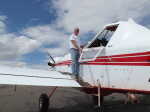City airport supports fight against range fires

by Tim Bondy
Mountain Home News
As efforts continued throughout the summer to battle a number of range fires across southern Idaho, a number of those missions originated at the Mountain Home Airport.
In May, Miguel Bilboa set up shop in a small office building at the local airport to help coordinate firefighting aircraft assigned to the airport in addition to wildland fire efforts across the region.
With region's ongoing drought over the last three years and a very active fire season in the area, pilots and ground crews have remained very busy, said Bilboa, a Single Engine Air Tanker, or SEAT, manager for the Bureau of Land Management.
"The Mountain Home SEATs location between the large air tanker base at Boise and the Pocatello, Idaho, location is almost perfect for fire fighting operations, Bilboa said.
One of those pilots flying those missions was Jim Mullins. His primary job was to help keep small wildfires small by dropping fire retardant from his Air Tractor 802 aircraft.
His single engine aircraft holds only about 800 gallons of fire retardant, but it suits the SEATs mission well, he said. That mission is one of a nimble and quick reaction wildfire attack operation.
SEATs pilots will fly about 105 hours during a normal fire season This year, Mullins said he will register close to 200 hours in his aircraft while helping to extinguish wildland fire in and around Idaho during his time flying out of the airport here.
Mullins has flown fire retardant missions on many different fires in Idaho during this fire season. These missions included support for the 280,000-acre Soda Fire and the nearly 100,000-acre Tepee Springs Fire.
SEATs pilots don't normally support those types of large fires called "project fires," but this year he got the call and did what was asked of him.
"You don't control fires like Soda and Teepee; you just try to herd them or guide them," Mullins said while explaining his primary mission as a SEATs pilot focuses on protecting structures and buildings.
SEATs aircraft operations out of the airport began in earnest in early July of this year when temperatures really stated heating up, according to Bilboa. At the peak of the fire season, there were seven SEATs aircraft working out of the Mountain Home Airport with a total of 12 different aircraft throughout the season.
"This Mountain Home SEATs base of operation exists to support fire fighters on the ground," Bilboa said regarding the importance of the BLM's mission at the airport.
While supporting the ground-based fire fighters, the locally based aircraft dropped more than 99,000 gallons of fire retardant on 34 different fires this year.
Being a SEATs pilot comes with many challenges, Mullins said. The biggest challenge of flying near the really large fires are normally weather related with low visibilities due to the thick smoke and turbulence, he added.
"We don't usually fly right over the tops of fires... we drop the retardant along the edges of the fire to create a sort of a fire break around the fire," Mullins said while highlighting the unpredictable behavior of wildfires.
With the recent favorable change in Idaho's fire weather, Mullins had some time off to enjoy the town's Air Force Appreciation Day events.
Mullins lived in Mountain Home for many years and attended the high school here until his senior year when his family moved to Oregon. Coming back to town as a SEATs pilot after leaving many years ago was quite an experience.
"Mountain Home was a small town when I left 52 years ago, and it still feels like a small town," said Mullins, who remembers when the city pool used to be located in Carl Miller Park.
While the SEATs mission was winding down, and Mullins expected to be leaving the place he still refers to as "his hometown" by the end of the week.
However, the BLM expects to return its SEATs contract planes, and many of its ground crew members to Mountain Home in 2016 for next year's fire season.
